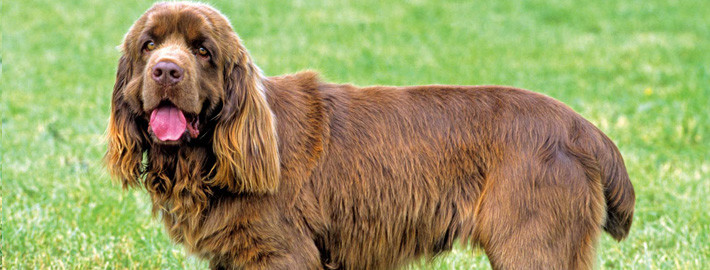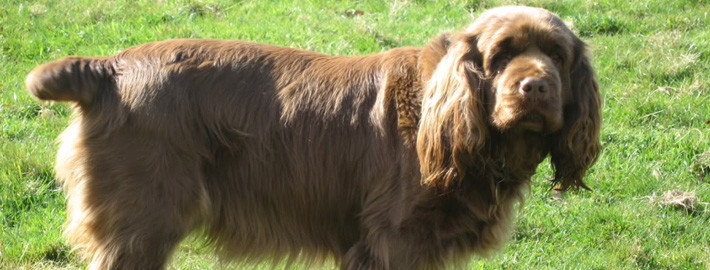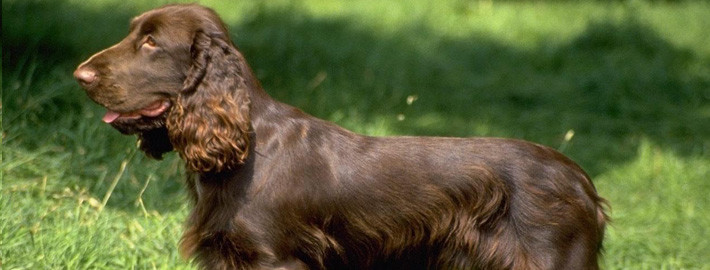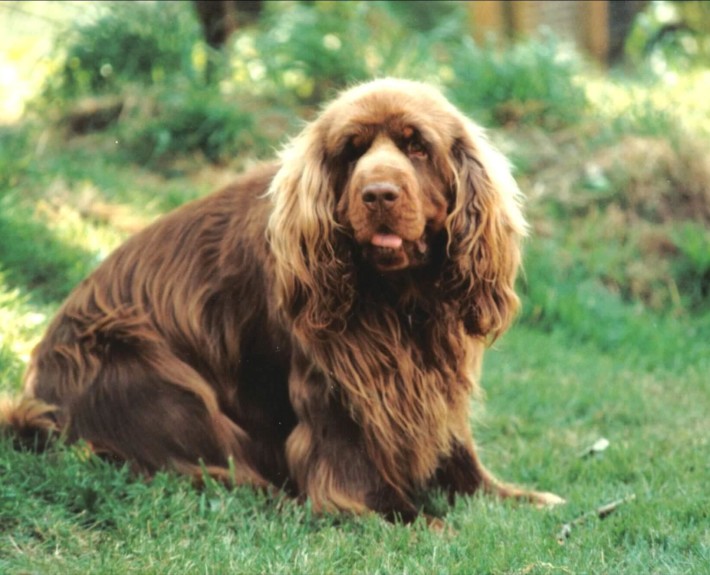What makes the Sussex Spaniel Unique?
Stern looking but sweet tempered, the Sussex Spaniel is a dog with a lot of heart that makes a great family companion for those living in both rural and urban areas.
Page Contents

Is the Sussex Spaniel Right For You?
Although they look solemn in nature, Sussex Spaniels are quite friendly and cheerful. These dogs actually have a pleasant disposition and they get along well with other pets and older children. Sussex Spaniels are not as playful or affectionate as some spaniels are.
Sussex Spaniels are intelligent dogs that greatly benefit from obedience training and proper socialization. Yet these dogs can be quite stubborn at times. Firm, consistent instruction is always the best way to teach them. Like many breeds, Sussex Spaniels that are rewarded for correct behavior with praise, treats, or toys are more likely to learn what their owners are attempting to teach them.
In 5 Words
- Devoted
- Calm
- Companionable
- Friendly
- Cheerful
Characteristics
Learn About the Sussex Spaniel
Description
General Description
Sussex Spaniels are large dogs with strong, low slung bodies that are rectangular in shape. Their backs are held at a level angle. They have broad skulls, square muzzles, long necks, and deep chests. Members of this breed also possess liver colored noses and large, hazel eyes. They usually have solemn expression on their faces, despite their friendly disposition. These dogs have pendant ears that are low set on their heads. Short legs are yet another feature of this breed. In places where the practice is not illegal, these dogs often have their tails docked. Members of this breed of possess a powerful gait.
Size
Males of this breed stand between 15 and 16 inches (38 and 40 centimeters) tall. Female Sussex Spaniels are somewhat shorter at 13 to 15 inches in height (33 to 38 centimeters). Dogs of both genders usually weigh between 40 and 45 pounds (18 and 21 kilograms).
Coat
Sussex Spaniels have a thick coat that serves to protect them from the dense underbrush of their home county. Their fur may be either completely flat or slightly wavy. Feathering is present on the tail, feet, neck, and legs. The feathering on their toes will be long enough to cover their toenails, which is a distinctive breed feature. These dogs are reddish brown in color, a shade described in the breed standards as ‘golden liver’. In earlier periods, there were also sandy and black Sussex Spaniels but this is no longer the case.
Short History of the Sussex Spaniel
In the late 1700s, a breed of gun dogs was created specifically to accompany hunters on foot through the thick, harsh undergrowth that was found in Sussex. The Field Spaniels, English Springer Spaniels and the now extinct Norfolk Spaniels were all breeds that contributed to form what is now the Sussex Spaniels. In 1884, these dogs were among the first admitted to the American Kennel Club. However, their popularity had begun to wane around the Second World War with only ten of their number being registered in 1947. By 2004, the breed had been classed as a Vulnerable Native Breed by the British Kennel Club due to low registrations. A bright spot occurred when a Sussex Spaniel won the best in show award at Westminster in 2009. This breed is currently more popular in the United States than it is any place else, including its’ homeland.
Temperament
Although they look solemn in nature, Sussex Spaniels are quite friendly and cheerful. These dogs actually have a pleasant disposition and they get along well with other pets and older children. Sussex Spaniels are not as playful or affectionate as some spaniels are. Their lower energy levels make members of this breed better suited to city life than other spaniels but they are still a fairly active breed that needs plenty of exercise. Sussex Spaniels will happily hunt birds if given the opportunity. Some members of this breed have a tendency to bark or howl on occasion and all of these dogs drool. A number of them may also behave aggressively towards unfamiliar dogs
Caring for Your Sussex Spaniel
General Health
Born in litters averaging around 5 puppies, Sussex Spaniels often live for up to 15 years. However, 11 to 12 years is more common. Breeders may need to keep their vets on their phone because these dogs can sometimes need cesarean section in order to successfully give birth. As is the case with any dog variety, there are some other health conditions that can arise from time to time. Owner should keep an eye out for signs of hip dyspepsia, a malformation of the aforementioned joint, because this ailment affects nearly half of all Sussex Spaniels. This condition is not considered to be serious limiting for members of this breed due to their builds. Another health issue that owners need to be aware of is otitis externa. This difficulty is common in spaniel breeds as their long, floppy ears trap debris and moisture, which in turn makes them prone to ear infections. The condition is treatable with antibiotics and/or cleaning fluids. However, it is best to keep pet’s ears clean to avoid any problems from occurring. Members of this breed may also occasionally suffer from spinal disc herniation and a variety of heart problems.
Care
Daily
As is the case with any dog, Sussex Spaniels should exercise on a daily basis. Several walks per day and playtime in a fenced-in area are recommended for members of this breed.
Weekly
Sussex Spaniels should have their long, thick fur brushed at least once a week. Owner will need to check for burrs and other debris that may have gotten caught in their coats and remove it. These dogs should also have their teeth cleaned on a regular basis to prevent health problems from arising.
Monthly
Flea, tick, and heartworm prevention medication is typically administered once a month to protect pets from harmful parasites.
Grooming & Bathing
Regular grooming is a must for members of this breed. Their ears should be kept clean to help prevent any infections from occurring. If the dogs have too much ear hair, it can be clipped at regular intervals to promote good health. Sussex Spaniels should have the excess hair that appears between the pads of their feet trimmed off. However, the hairs between the toes should be left alone. Their toenails should be clipped as needed.
Exercise & Training
Sussex Spaniels are intelligent dogs that greatly benefit from obedience training and proper socialization. Yet these dogs can be quite stubborn at times. Firm, consistent instruction is always the best way to teach them. Like many breeds, Sussex Spaniels that are rewarded for correct behavior with praise, treats, or toys are more likely to learn what their owners are attempting to teach them. However, people that own one of these dogs will have to be patient as well because Sussex Spaniels will sometimes outwit the humans that are giving them their lessons.











